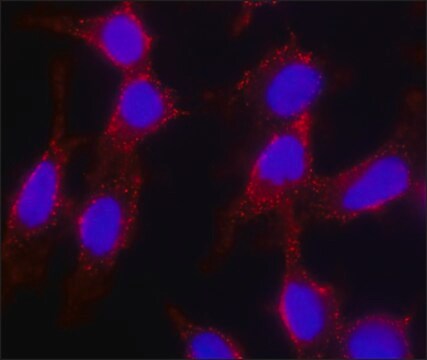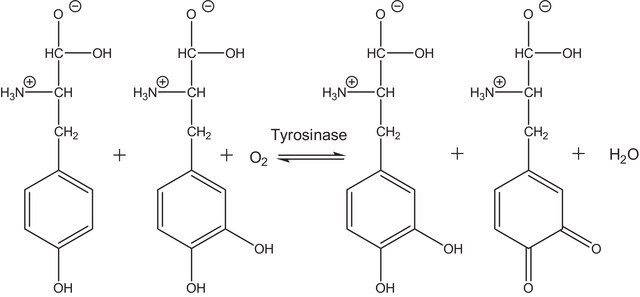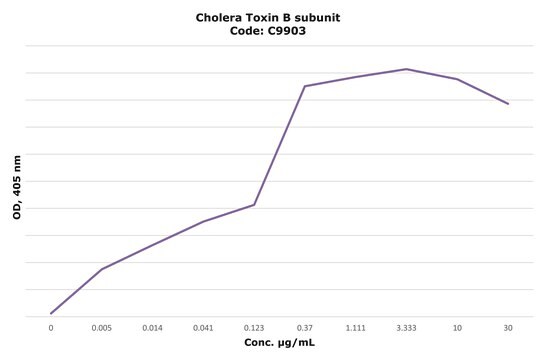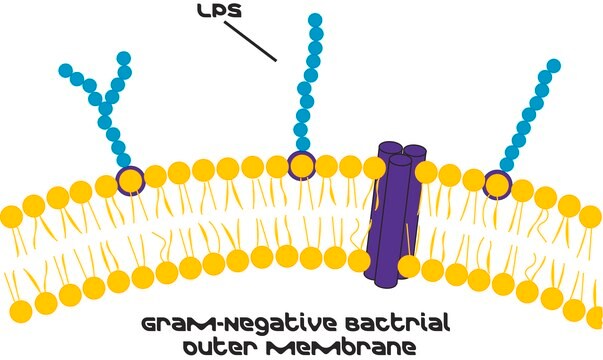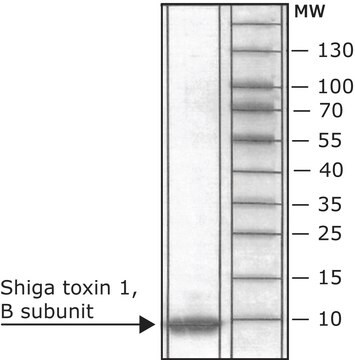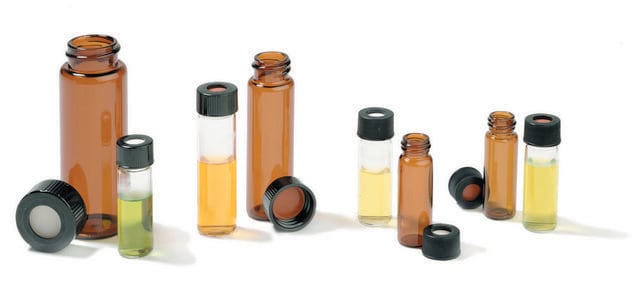E8656
Heat-Labile Enterotoxin, B subunit from E. coli
recombinant, expressed in Pichia pastoris, >90% (SDS-PAGE), lyophilized powder
Synonyme(s) :
LTB
Se connecterpour consulter vos tarifs contractuels et ceux de votre entreprise/organisme
About This Item
Code UNSPSC :
12352200
Nomenclature NACRES :
NA.77
Produits recommandés
Produit recombinant
expressed in Pichia pastoris
Niveau de qualité
Essai
>90% (SDS-PAGE)
Forme
lyophilized powder
Conditions d'expédition
wet ice
Température de stockage
2-8°C
Application
Heat-Labile Enterotoxin, B subunit (LTB) from E. coli has been used in enzyme-linked immunosorbent assay (ELISA).
Actions biochimiques/physiologiques
Enterotoxigenic Escherichia coli causes diarrhea through its heat-labile enterotoxin (LT). The LT is a periplasmic protein composed of one A subunit (LTA, 27 kDa) and five non-covalently associated B subunits (LTB, 11.6 kDa each) forming a ring-like pentamer. LTB has high affinity towards the toxin receptor ganglioside GM1, a glycosphingolipid found ubiquitously on the surface of mammalian cells. Ganglioside GM1 facilitates the delivery of the A subunit to the cytosol of the target cell resulting in persistent synthesis of cAMP and subsequently diarrhea. This characteristic makes LTB a good label for microglial cells (due to the enrichment of ganglioside GM1 on their cell surface). In addition, studies made mostly with animal models demonstrated that recombinant LTB could stimulate strong serum and mucosal immune responses against LT. Other studies have indicated that LTB could be used as a potent mucosal adjuvant.
Heat-Labile Enterotoxin, B subunit (LTB) is a good label for microglial cells. In addition, recombinant LTB stimulates strong serum and mucosal immune responses against heat-labile enterotoxin (LT). Other studies have indicated that LTB could be used as a potent mucosal adjuvant.
Caractéristiques et avantages
This compound is a featured product for Cyclic Nucleotide research. Click here to discover more featured Cyclic Nucleotide products. Learn more about bioactive small molecules for other areas of research at sigma.com/discover-bsm.
Forme physique
Lyophilized from a solution containing Heat-Labile Enterotoxin, B subunit in 0.05 M Tris buffer, pH 7.5, 0.2 M NaCl, 3 mM NaN3, and 1 mM sodium EDTA.
Remarque sur l'analyse
The activity is measured by ELISA using ganglioside GM1-coated plates (Cat. No. G7641). LTB at various concentrations is incubated on the ganglioside GM1 coated wells, followed by anti-cholera toxin antibody (Cat. No. C3062), and peroxidase-labeled goat anti-rabbit IgG (Cat.No. A0545) as the secondary antibody. Binding saturation of 50% may be achieved with = 0.12 μg/mL of LTB.
Mention d'avertissement
Warning
Mentions de danger
Conseils de prudence
Classification des risques
Acute Tox. 4 Dermal - Aquatic Chronic 3
Code de la classe de stockage
11 - Combustible Solids
Classe de danger pour l'eau (WGK)
WGK 1
Point d'éclair (°F)
Not applicable
Point d'éclair (°C)
Not applicable
Équipement de protection individuelle
Eyeshields, Faceshields, Gloves, type ABEK (EN14387) respirator filter
Faites votre choix parmi les versions les plus récentes :
Déjà en possession de ce produit ?
Retrouvez la documentation relative aux produits que vous avez récemment achetés dans la Bibliothèque de documents.
Les clients ont également consulté
Safety and immunogenicity of escalating dosages of a single oral administration of peru-15 pCTB, a candidate live, attenuated vaccine against enterotoxigenic Escherichia coli and Vibrio cholerae
Chen WH, et al.
Clinical and Vaccine Immunology : CVI, 22(1) (2015)
Preformulation Characterization and Stability Assessments of Secretory IgA Monoclonal Antibodies as Potential Candidates for Passive Immunization by Oral Administration
Hu Y, et al.
Journal of Pharmaceutical Sciences, 109(1) (2020)
Sandra Scheiblhofer et al.
Vaccine, 39(32), 4399-4403 (2021-07-07)
The skin represents an attractive target tissue for vaccination against respiratory viruses such as SARS-CoV-2. Laser-facilitated epicutaneous immunization (EPI) has been established as a novel technology to overcome the skin barrier, which combines efficient delivery via micropores with an inherent
Plastid expression of a double-pentameric vaccine candidate containing human papillomavirus-16 L1 antigen fused with LTB as adjuvant: transplastomic plants show pleiotropic phenotypes
Waheed MT, et al.
Plant Biotechnology Journal, 9(6) (2011)
Notre équipe de scientifiques dispose d'une expérience dans tous les secteurs de la recherche, notamment en sciences de la vie, science des matériaux, synthèse chimique, chromatographie, analyse et dans de nombreux autres domaines..
Contacter notre Service technique




